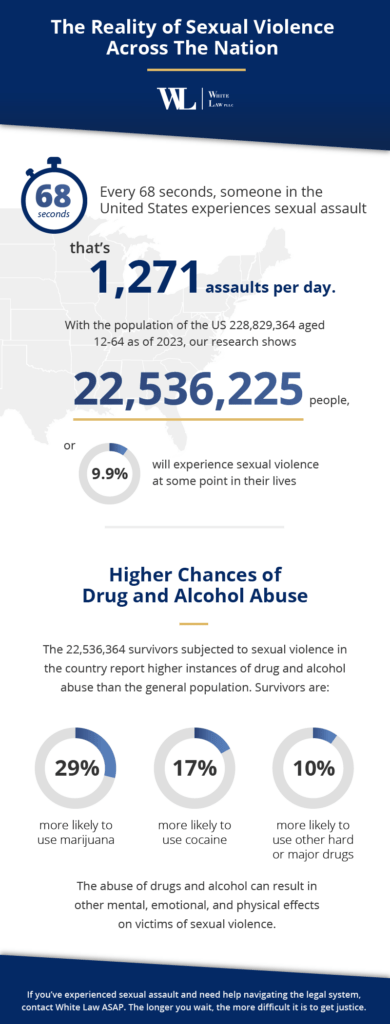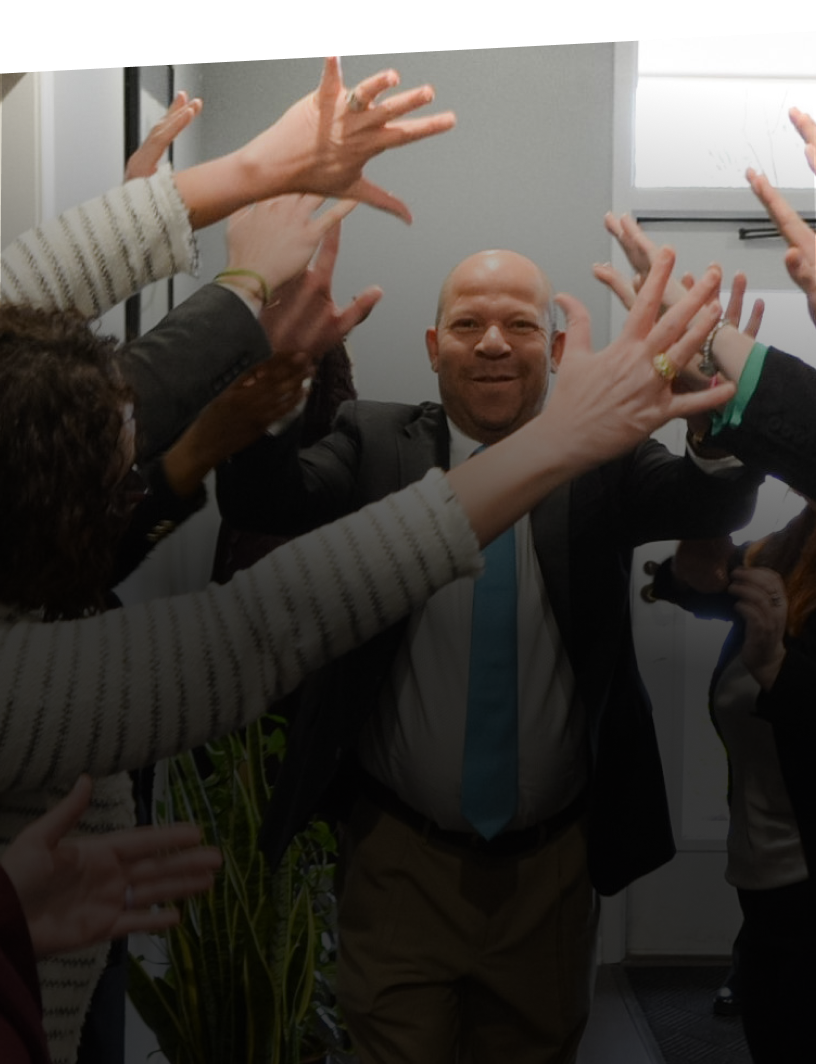Sexual violence represents a significant concern for many people across the nation. Someone in the United States experiences sexual assault every 68 seconds, which equates to 1,271 assaults daily. Hundreds of thousands of Americans are affected by violence of a sexual nature every year.
The legal team at White Law PLLC conducted an in-depth study into the statistics to better explain the reality of sexual violence across the nation, developing a campaign to raise awareness about the issue, support and empower survivors, and create benchmarks for improvement.
You can learn more about this type of violence and how to respond in the aftermath with a sexual abuse lawyer.
What Exactly Is Sexual Violence?
Professionals consider “sexual violence” a non-legal term. Sexual violence can refer to crimes like sexual assault, sexual abuse, and rape. You can use this term when talking about any sexual behavior or contact that takes place without the expressed consent of all parties.
Studies show that in 80% of sexual assault cases, the victims know the perpetrator. Indeed, 93% of juvenile victims who report sexual assault to the police know the person who abused them.
You can see a further breakdown of the relationships between perpetrators and victims of sexual violence in the table below:
| Sexual Abuse Statistic | Relationship to Victim |
| 59% | Acquaintances |
| 34% | Family Members |
| 7% | Strangers |
With the population of the US 228,829,364 aged 12-64 as of 2023, our research shows out of those individuals, 22,536,225 will experience sexual violence at some point in their lives. Therefore, 9.85% of people around the country will go through this type of violence.
Who faces the greatest risk of sexual violence in the United States? While data on this issue is limited, the available statistics reveal significant disparities among racial and ethnic groups. According to the figures, 18% of White women, 7% of Asian/Pacific Islander women, 19% of Black women, 24% of women of mixed race, and a staggering 34% of American Indian or Alaskan Native women will experience sexual violence at some point in their lives. These numbers underscore the disproportionate vulnerability of women of color to sexual violence, highlighting an urgent need for awareness, prevention, and support tailored to these communities
Approximately 6.07% of the U.S. population identifies as LGBTQ, and alarming statistics reveal that members of the LGBTQ community are four times more likely to experience sexual violence compared to their heterosexual counterparts. Recent data indicates that 39.4% of LGBTQ individuals will face sexual abuse at some point in their lives, highlighting the critical need for targeted awareness, prevention efforts, and support systems for this vulnerable community.
As you can see, many people will face sexual violence in the United States.
As a spokesperson from White Law PLLC says, “9.85% of people in the United States will become victims of sexual violence—a staggering statistic that reminds us just how urgent this crisis is. The need for awareness and change is undeniable.”
Long-Term Effects of Sexual Violence
Sexual violence can result in a wide range of long–term mental, emotional, and physical impacts for victims. Many people do not have full information about the lingering effects of sexual trauma.
Medical professionals and others who study sexual violence report that victims of this type of abuse may experience:
Lasting Effects on Their Mental Health
Victims of sexual violence are more likely to have depressive or suicidal thoughts than their counterparts. 94% of women who experience sexual assault report symptoms of post-traumatic stress disorder (PTSD) in the aftermath of the attack.
Victims may also report feelings of derealization. Derealization makes the world feel unreal, dreamlike, or foggy. Individuals may experience derealization as their minds try to protect them from triggering thoughts.
Finally, many individuals who experience sexual violence blame themselves for what happened, leading to painful feelings of guilt. However, these acts are never the fault of the victim. The perpetrator holds full responsibility.
Higher Chances of Drug and Alcohol Abuse
The 22,536,364 survivors subjected to sexual violence in the country report higher instances of drug and alcohol abuse than the general population. Survivors are:
- 28.57% more likely to use marijuana
- 16.78% more likely to use cocaine
- 10% more likely to use other hard or major drugs
The abuse of drugs and alcohol can result in other mental, emotional, and physical effects on victims of sexual violence.
Effects on Their Physical Health
Finally, victims of sexual violence are at an increased risk of experiencing a sexually transmitted infection or unwanted pregnancy.
Considering all the effects of sexual violence, White Law PPLC states, “The impact of sexual violence extends far beyond the incident itself, often resulting in lasting emotional, mental, and physical challenges.
“From PTSD to increased risks of substance abuse, the trauma affects every part of a survivor’s life, underscoring the critical need for compassionate support and prevention strategies.”
Steps to Healing
Sexual violence can have devastating effects on victims, but hope for healing and recovery remains. You can explore tips for healing after this kind of attack as you learn more about sexual assault.
Many people find the following strategies helpful when recovering from sexual violence:
Getting Help from a Trusted Friend
Connecting with a trusted party can help individuals take the first steps toward recovering from sexual violence. Opening up about what happened and discussing their feelings without hiding their thoughts can help victims feel less alone.
Joining a Support Group
Many medical facilities, religious groups, and community organizations around the country offer support groups for victims of sexual violence. Individuals who join these groups often feel less isolated and alone during their journey to recovery.
Focusing on Self-Soothing
Victims of sexual violence may experience unexpected triggers that can cause anxiety, stress, and other severe mental and emotional effects. They may need to take time to create exercises that allow them to self-soothe when facing these triggers.
For example, many victims learn breathing exercises that can quickly reduce the anxiety they feel, allowing them to get back their peace of mind after an anxiety attack.
Exploring Other Activities to Recover
Individuals who face sexual violence often face challenges reconnecting with their bodies and feelings. Fortunately, several activities can help with this reconnection. Examples of activities that can help with this process include:
- Yoga
- Journaling
- Meditation
Medical professionals may recommend trying several activities to find one or more that help.
Decreasing the Stats
It’s in the best interests of everyone around the country to decrease the prevalence of sexual violence. Several strategies may reduce the number of people who experience sexual abuse every year through sexual violence prevention.
Changing Social Norms
Adjusting social norms can take time, but it can affect society. Shifting norms to focus more on safety and the reduction of violent behavior may reduce overall instances of sexual abuse.
Having open and honest conversations about sexual violence statistics is also a meaningful way to make these numbers decrease.
Offering More Educational Opportunities
Increasing the knowledge people have about relationships and sexual education can reduce overall instances of sexual violence. In-depth courses may equip individuals with skills that can help them avoid sexual abuse.
Creating Safe Environments
Reducing the amount of sexual violence around the country will require the creation of safe and secure environments in:
- Schools
- College campuses
- Workplaces
These places need to provide an opportunity for victims of sexual violence to come forward about what they experienced. Additionally, we need to increase the opportunities for the empowerment of women and girls.
As a spokesperson from White Law said, “We all have a role to play in ending sexual violence. By raising awareness, supporting survivors, and fostering safe environments, we can work together to create a safer, more empathetic society for everyone.”
Increasing the Number of Treatment Facilities
Adding to the number of facilities available to provide treatment to individuals who experience sexual violence can help with recovery.
Get Legal Assistance After Experiencing Sexual Violence
Our team at White Law PLLC understands the reality of sexual violence across the nation. We can support you if you experience this type of abuse, potentially helping you secure the compensation you need from the liable party.



